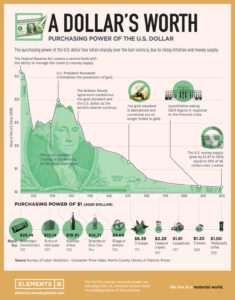Lesson 17: Inflation and Its Effects on Individuals
The impact of inflation on personal finance is profound. For individuals, inflation is a hidden tax that reduces the value of their money without them realizing it. Wages, while they may increase nominally, rarely keep pace with inflation in the long term, leaving people with less purchasing power. For example, if inflation is 5% annually, a person who receives a 5% raise may feel like they’ve broken even, but the reality is that their wages have not kept up with the increasing cost of living. As a result, people find themselves unable to afford the same goods and services they once could, leading to a decline in their standard of living.

Inflation also severely impacts savings and investments. For those who rely on cash savings to secure their financial future, inflation is particularly destructive. Savings held in traditional bank accounts or under the mattress lose value over time as the purchasing power of the currency decreases. Even investments that were once considered relatively safe, such as bonds, may lose value as inflation rises, eroding the real return on investment. In times of high inflation, people often turn to assets that are considered “inflation hedges,” such as real estate or commodities, but these investments can be difficult to access for many individuals.
To mitigate the effects of inflation, individuals must adopt strategies to protect their wealth. One of the most effective ways is through diversification—holding a mix of assets that are less vulnerable to inflationary pressures. Real estate, stocks, commodities, and even foreign currencies can act as a hedge against inflation. Another strategy is investing in assets that tend to rise in value during inflationary periods, such as precious metals like gold. However, these strategies often require a level of financial literacy and access to capital that may not be available to everyone, especially those in lower-income brackets.
Inflation also has a disproportionate impact on different social classes. The poor and middle class are particularly vulnerable to inflation, as their wealth is often tied up in cash savings or fixed-income assets. For these groups, inflation leads to a reduction in purchasing power, which exacerbates inequality and deepens social divides. On the other hand, the wealthy, who hold their wealth in assets like stocks, real estate, and businesses, often benefit from inflation. As prices rise, so too does the value of their assets, further widening the wealth gap. This discrepancy in the effects of inflation contributes to social instability and economic inequality, as the rich get richer while the poor and middle class struggle to make ends meet.
Asset inflation—rising prices in real estate, stocks, and other investment vehicles—also plays a crucial role in exacerbating inequality. The wealthiest individuals and institutions are more likely to own these assets and, as such, see their wealth grow during inflationary periods. Meanwhile, those without significant investments in such assets see their wealth eroded by inflation. This phenomenon creates a feedback loop, where the rich accumulate more wealth while the poor and middle class are left behind. It also distorts the real economy, as rising asset prices may not reflect improvements in productivity or economic growth, but rather an inflationary bubble.
Inflation is not just a theoretical economic concept; it has real and tangible effects on individuals and societies. From the erosion of purchasing power to the widening wealth gap, inflation has a far-reaching impact on personal finance, social stability, and the broader economy. As fiat currencies continue to lose value over time, individuals must become more aware of the risks posed by inflation and take steps to protect their wealth. For society as a whole, addressing the root causes of inflation and ensuring a stable monetary system is crucial to maintaining economic stability and preventing the social and economic breakdowns that have historically resulted from unchecked inflationary policies.
